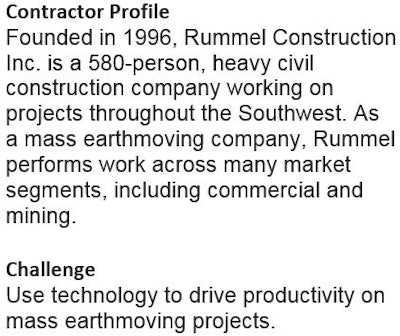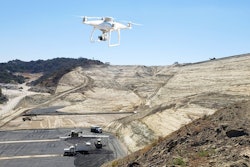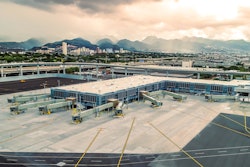
Rummel Construction is a Scottsdale, Ariz.,-
In support of an almost 3,500-acre master planned community project, the company was contracted to excavate 659,000 cubic yards of material and finish 773,000 square yards.
Shaun Tindell, GPS Manager at Rummel, says, “Nearly every type of our technology-enabled equipment – from GNSS rovers to machine controlled graders to drone mapping systems – was used on this site development.”
Specifically, the Rummel crews relied on the Trimble SPS986 GNSS Smart Antenna as a rover system to complete site layout, verify survey and check grade. Then, Rummel’s motor graders, dozers and scrapers, nearly all of which were outfitted with the Trimble Earthworks Grade Control Platform or the GCS900 3D Grade Control System, went to work excavating and finishing surfaces, while a drone above helped track the material quantities.
“Grade control in particular really pays off when balancing material ahead of finished grading on a project this size. It’s a one-and-done process that leaves a beautiful, finished product that is exactly to spec,” says Tindell.
This is just one of many projects that have benefited from Rummel’s technology-forward approach to projects, a quest that began about 16 years ago.
Technology evolution
The economic downturn in 2007 hustled Rummel into a strategic shift. “When residential work dissipated, we moved to more commercial and mining work, and then to heavy civil and highway work. That move really facilitated our interest and investment in technology,” said Tindell.
With help from SITECH Southwest, Rummel was introduced to Trimble’s machine control family of products.
“We tried the Trimble GCS900 3D Grade Control System on a rental dozer and motor grader on a roadway slope repair project in Page, Ariz.,” said Tindell. “Our operators said that it was pretty user friendly, and by the time we were done we were so impressed that we decided to purchase several platforms.”
 All of Rummel’s rovers are equipped with Trimble Siteworks software, which has proven very efficient at handling the 3D data sets.Trimble
All of Rummel’s rovers are equipped with Trimble Siteworks software, which has proven very efficient at handling the 3D data sets.Trimble
“We transitioned to six Trimble Earthworks systems in the last few years for motor graders and just got our first Earthworks-equipped dozer,” confirmed Tindell. “Even better, three of the motor grader systems are mastless, which is amazing for both flexibility and safety.”
The mastless grader system gives operators an improved range of blade motion, allowing for machine control in applications where it was previously not possible. The system puts one GNSS receiver on the cab and one on the gooseneck of the machine to eliminate the tangle of masts and cables traditionally located on the blade.
“And we don’t have operators hanging out of the cab to put an antenna on,” he added.
All of Rummel’s rovers are equipped with the Trimble Siteworks software, which Tindell says is very efficient at handling the 3D data sets.
Partner advantage
When asked about training on the rovers, grade control systems or associated software, Tindell says it’s been pretty much on-the-job.
 Rummel crews master grade tech with on-site support from SITECH Southwest. Shaun Tindell, GPS manager at Rummel, says, "They provided a manual for the routine operations, but they’ll show up on our jobs and walk us through more advanced stuff," as needed.Trimble
Rummel crews master grade tech with on-site support from SITECH Southwest. Shaun Tindell, GPS manager at Rummel, says, "They provided a manual for the routine operations, but they’ll show up on our jobs and walk us through more advanced stuff," as needed.Trimble
SITECH’s responsiveness has been particularly valuable as Rummel has grown. “Not only has the scope and scale of our jobs grown significantly, but so has our fleet. We went from 10 blades and five rovers eight years ago, to now having 66 pieces of equipment.”
When asked why Trimble, Tindell said, “There are fewer problems with Trimble, less rework and less wasted time. In fact, our supervisors can tell at a glance when a Trimble machine performed a task – the difference between grade control products is obvious.”
In December 2019, Rummel added a drone division, complete with Trimble Stratus with Propeller RTK platform for mapping topographical information and capturing high-quality project photography and videography.
While use of the drone was limited in 2020, the potential is enormous on large projects such as the master planned community development
Tindell said, “This is an enormous community that we will likely be working on for another 10 years. Right now, we use our drone almost exclusively for calculation of excavation quantities, and occasionally to shoot a few pictures or videos for an owner. We believe that will expand this year to include site progress mapping and management.”
No matter the scope and scale of the project, Tindell believes the benefits are clearly evident in the bottom line and the finished product. He concluded, “We’re easily 20-30% more efficient today than just a 5-10 years ago. That’s the clear value of technology.”
Vicki Speed has been a freelance writer specializing in the architecture, engineering and construction space for more than 25 years. She has an interest in and passion for all things about the industry from contracts and risk management to people, processes, equipment and, especially, technology. Trimble
Trimble



















